PREVIOUS
UNESCO World Heritage Sites - India
UNESCO World Heritage Sites - India
- - - - - - - - - - - - - -
Questions based on UNESCO World heritage sites in India can come up in every exam which tests General awareness of the candidates. Since these sites are just a handful, they give good return reward in form of marks. Hence, we suggest you go through these UNESCO sites every now and then to ensure those easy marks. .
.
UNESCO Sites
- There are 36 (28 cultural, 7 natural and 1 mixed)World Heritage Sitesin India that are recognised by the United Nations Educational, Scientific and Cultural Organization(UNESCO) as of July 2017.
- These are places of importance of culturalor natural heritageas described in the UNESCO World Heritage Convention, established in 1972.
- India’s first two sites inscribed on the list in 1983 were the Agra Fortand the Ajanta Caves.
- A tentative list of further sites/properties submitted by India for recognition includes 44 sites. The cultural sites in India are marked by their brilliant craftsmanship on stone. Most of the temples of India which are inscribed on this list are built in stone, without any mortar and with sculpture carved on it.
- Three new sites – "Archaeological Site of NalandaMahavihara (Nalanda University)" at Nalanda, Bihar, "Capitol Building Complex – The Architectural Work of Le Corbusier" in Chandigarh and "Khangchendzonga National Park, Sikkim" have been added to the list in July, 2016.
- In July, 2017 the Historic City of Ahmadabadwas added to the list, making it India's UNESCO World Heritage Site
.
1. Mahabodhi Temple Complex at Bodh Gaya, Bihar ( 2002)
- The first temple was built by Emperor Ashokain the 3rd century BC (260 BC) around the Bodhi TreeFicus religiosa(to the west of the temple).
- Here Siddhartha Gautama Buddhawas enlightened
- it is the oldest temple in the Indian sub-continent built during the "Golden Age" of Indian culture credited to the Gupta period.
 .
.
2. HUMAYUN’S TOMB,DELHI,1993
- It is the first tomb built with several innovations, set at the centre of luxurious gardens with water channels, was the precursor monument to the Taj Mahal.
- It was built in 1569–1570 by the second Mughal EmperorHumayun’s widow Biga Begum (Hajji Begum).
- Its Mughal architectural stylehas been acclaimed as the "necropolis of the Mughal dynasty" for its double domed elevation provided with Chhatris.
- The tomb is built with a char-bagh(fourfold) layout with two gates, one on the south and the other on the west.
- It has a number of water channels, a pavilion and a bath.
 .
.
3. Qutb Minar and its Monuments, Delhi,1993
- Built in the beginning of the 13th century, the complex of structures comprises itineraries, the Alai DarwazaGate (1311), the Alai Minar (an incomplete mound of the intended Minar or tower), the Qubbat-ul-Islam Mosque(the earliest existing mosque in India), the tomb of Iltumish, and an Iron Pillar.
- a shining iron pillar erected at the centre of the complex, with inscriptions in Sanskrit, of the Chandra Gupta IIperiod is a moot witness.
- History records its construction, initially by Qutubuddin Aibakin 1192, its completion by Iltumish(1211–36) and again by Alauddin Khalji (1296–1316).
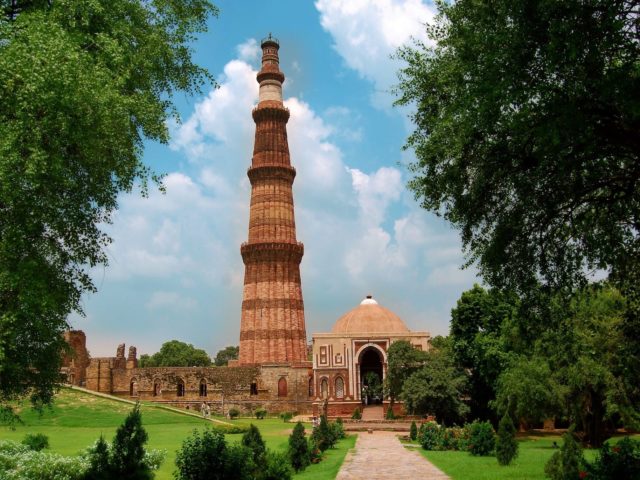
.
4. Red Fort Complex,Delhi,2007
- Red Fort Complex, also known as Lal Qila is a palace fort built by Shahjahan(1628–58), as part of his new capital city of Shahjahanabad.
- located to the north of Delhi.
- The architectural design of the structures built within the fort represents a blend of Persian, Timuri and Indian architectural styles;
- Isfahan, the Persian Capital is said to have provided the inspiration to build the Red Fort Complex.
- The palace complex has been fortified by an enclosure wall built with red sand stone (hence the name Red Fort).

.
5. Churches and Convents of Goa,Goa,1986
- Churches and Convents of Goaare built by the Portuguesecolonial rulers of Goa.
- These monuments are mainly in the former capital of Velha Goa.
- The most significant of these monuments is the Basilica of Bom Jesus, which enshrines the tomb containing the relics of Francis Xavier.
- These monuments of Goa, also known as the "Rome of the Orient”.
- The monuments are built in laterites and walls plastered with limestone mortar mixed with broken shells.
- For this reason, the monuments need constant maintenance to prevent deterioration due to monsoon climatic conditions, and thus keep them in good shape.
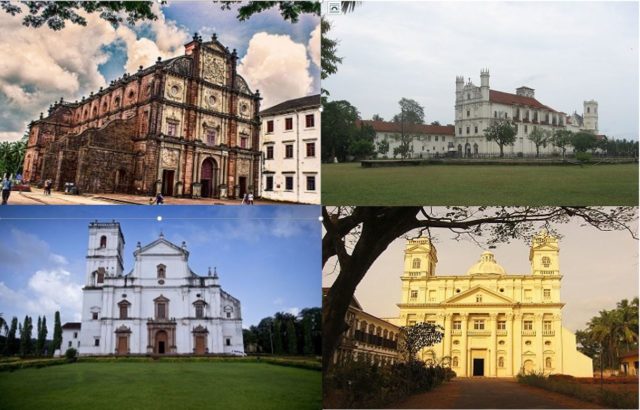
.
6. Champaner-Pavagadh Archaeological Park,Gujarat,2004
- Champaner-Pavagadh Archaeological Parkis situated in Panchmahal districtin Gujarat, India.
- The Kalikamata Temple& Jain Templeon top of the Pavagadh Hill is considered to be an important shrine, attracting large numbers of pilgrims throughout the year.
- The site is the only complete and unchanged Islamicpre-Mughal.
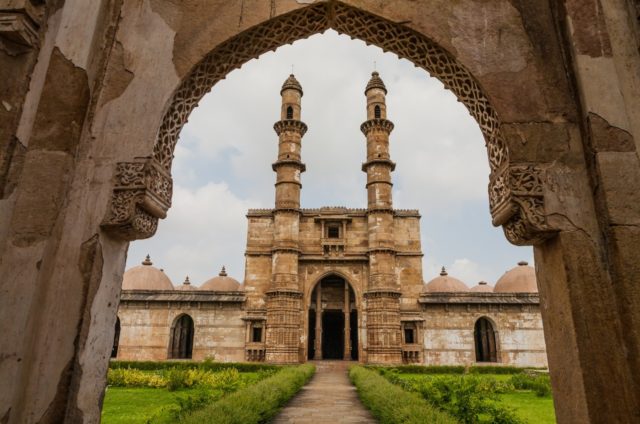
.
7. Group of Monuments at Hampi, Karnataka,1986
- Hampi town,is on the banks of the river Tungabhadra River
- Hampi subsumes the ruins of Vijayanagara, which was the former capital of the powerful Vijayanagara Empire.
- Dravidiantemples and palaces abound in Hampi.
- Hampi, has the Virupaksha Temple(different from Pattadakal's Virupaksha Temple) and several other monuments.
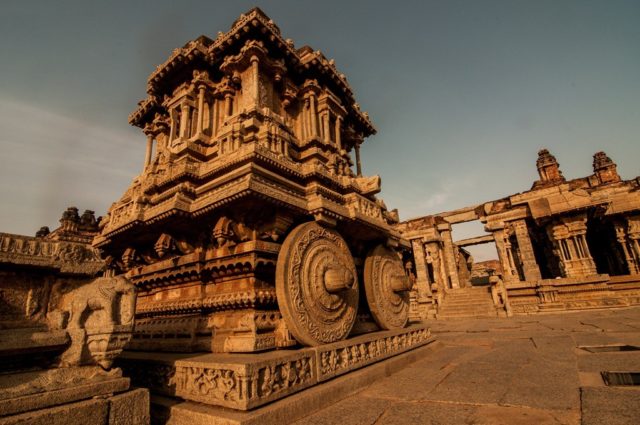
.
8. Group of Monuments at Pattadakal,Karnataka,1987
- The Group of monuments in Pattadakal cover a remarkable series of nine Hindu temples, as well as a Jain sanctuary in northern Karnataka.
- In this group of temples, the Virupaksha Temple, built c. 740 by Queen Lokamahadevi to commemorate her husband's (King Vikramaditya II) victory over the Pallava kings from the south, is considered the most outstanding architectural edifice (This is different from the Virupaksha Templeat Hampi.)
- These are a remarkable combination of temples built by the Chalukya Dynastyin the 6th to 8th century at Aihole, Badamiand Pattadakal, the latter city was known as the "Crown Rubies".
- The temples represent a remarkable fusion of the architectural features of northern (Nagara) and southern (dravida)
- Pattadakal is considered a Hindu holy city and within the heritage complex are eight temples dedicated to Shiva, a ninth shaivitesanctuary called the Papanatha Temple, and a Jain Narayana temple.
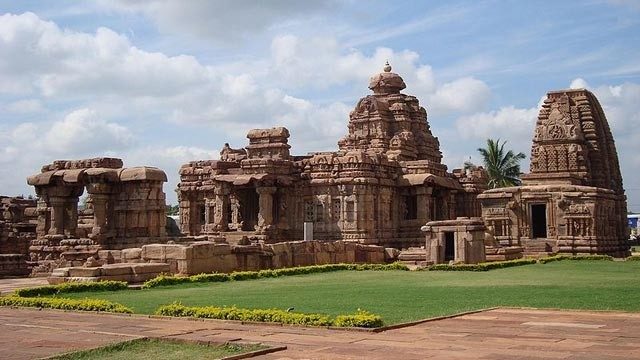 .
.
9. Buddhist Monuments at Sanchi, Madhya Pradesh,1989
- Buddhist Monuments at Sanchi, are a group of Buddhist monuments dated between 200 BC and 100 BC.
- The site, have also been developed in the 3rd century BC, by Emperor Ashoka of the Mauryan Empire.
- The principal monument is Stupa 1 dated to the 2nd century and 1st century BC.
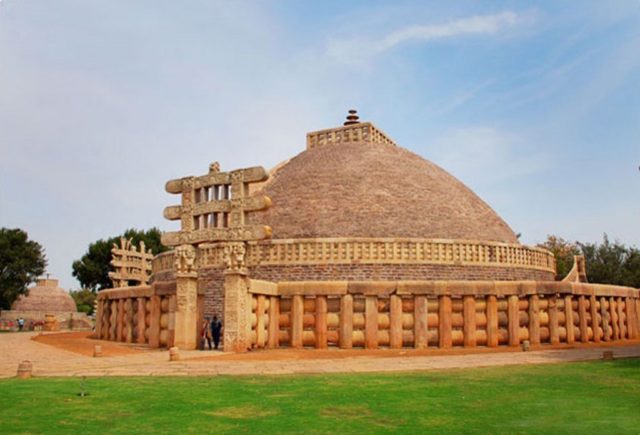
.
10. Rock Shelters of Bhimbetka, Madhya Pradesh,2003
- It is located in the foothills of the Vindhya range of hills.
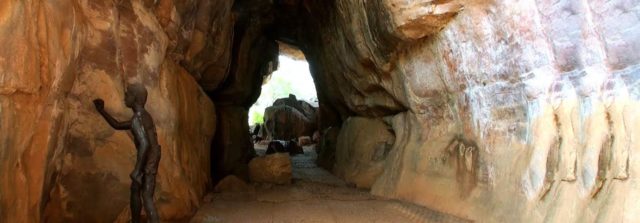
.
11. Khajuraho Group of Monuments,Madhya Pradesh,1986
- Khajuraho Group of Monumentsattributed to the Chandela dynastywhich, under sovereignty of Gurjar Pratihars reached its glory.
- The ensemble of monuments that have survived belong to the Hinduand Jain Religious
- the best example of this outstanding feature is seen in the Kandariya Temple.
 .
.
12. Ajanta Caves,Maharashtra,1983
- Ajanta Caves , are Buddhist
- The caves depict richly decorated paintings, frescoes, which are reminiscent of the Sigiriya paintings in Sri Lankaand sculptures.
- As a whole, there are 31 rock-cutcave monuments which are unique representations of the religious art of Buddhism.
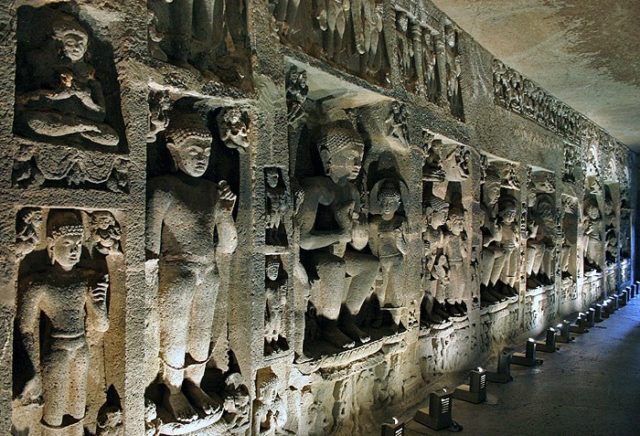
.
13. Ellora Caves,Maharashtra,1983
- Ellora Cavesalso known as Ellora Complex are a cultural mix of religious arts of Buddhism, Hinduismand Jainism.
- These are 34 monasteries and temples sculpted contiguously into rock walls of a high basalt cliff, which are seen along a length of 2 kilometres .
- Dated to 600 to 1000 AD, they are a reflection of artistic creation of the ancient civilization of India.
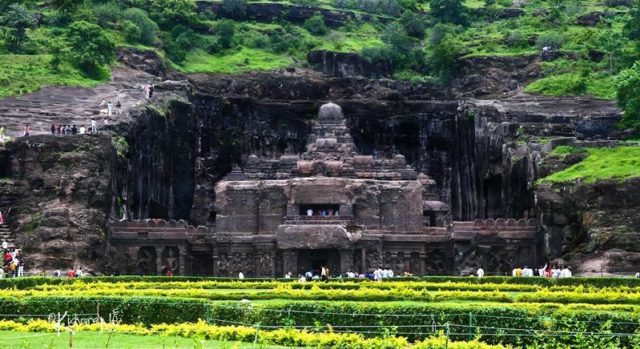
.
14. Elephanta Caves,Maharashtra,1987
- The Elephanta Cavesare a network of sculpted caves located on Elephanta Island, or Gharapuri (literally "the city of caves") in Mumbai Harbour, 10 kilometres (6.2 mi) to the east of the city of Mumbai.
- The island, located on an arm of the Arabian Sea, consists of two groups of caves — the first is a large group of five Hindu caves, the second, a smaller group of two Buddhist caves.
- The Hindu caves contain rock cut stone sculptures, representing the Shaiva Hindu sect, dedicated to the god Shiva.
- The caves are hewn from solid basalt rock.
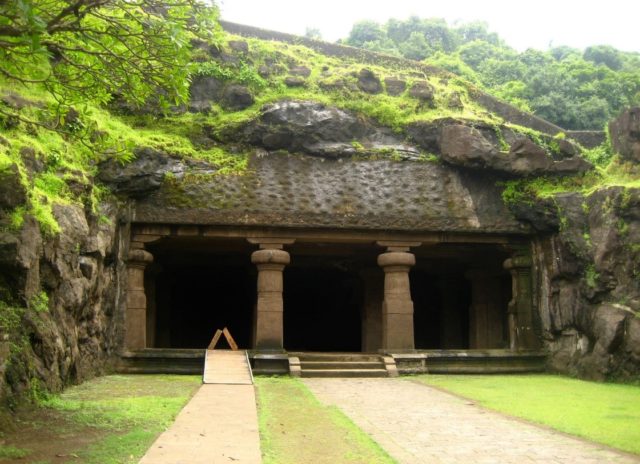
. .
15. Chhatrapati Shivaji Terminus (formerly Victoria Terminus),Maharashtra ,2004
- Chhatrapati Shivaji Terminusis a historic railway station in Mumbai, which serves as the headquarters of the Central Railways.
- It is one of the busiest railway stations in India, and serves Central Railway trains terminating in Mumbai as well as the Mumbai Suburban Railway.
- The station was designed by Frederick William Stevens, a consulting architect in 1887–1888.
- It took ten years to complete and was named "Victoria Terminus" in honour of the Queen and Empress Victoria;
- it was opened on the date of her Golden Jubilee in 1887.
- This famous architectural landmark in Gothic style was built as the headquarters of the Great Indian Peninsular Railway.
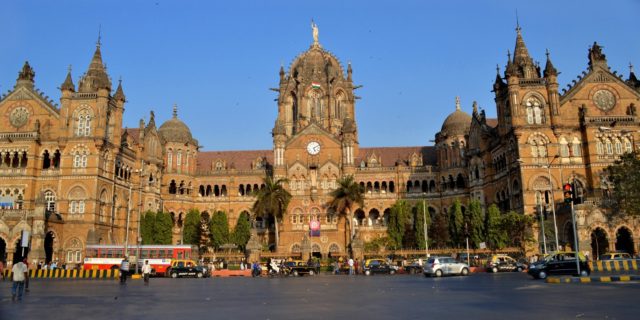
.
16. Sun Temple, Konârak,Orissa , 1984
- Konark Sun Temple is a 13th-century Sun Temple (also known as the "Black Pagoda"), at Konark, in Od
- Located on the east coast of the Bay of Bengal in the Mahanadi Delta, it is built in the form of the chariotof Surya(Arka), the sun god with 24 wheels, and is heavily decorated with symbolic stone carvings and led by a team of six horses.
- It was constructed from oxidizing weathered ferruginous sandstoneby King Narasimhadeva Iof the Eastern Ganga Dynasty.
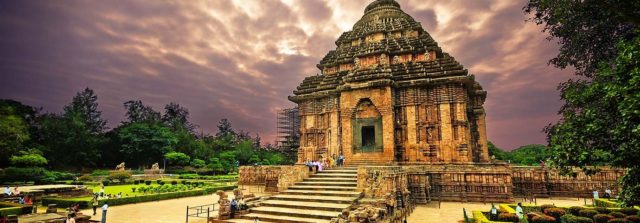
.
17. Jantar Mantar, Jaipur,Rajasthan, 2010
- The Jantar Mantarin Jaipuris a collection of architectural astronomical instruments, built by Maharaja (King) Jai Singh II at his then new capital of Jaipur between 1727 and 1734.
- It is modelled after the one that he had built at the Mughalcapital of Delhi.
- He had constructed a total of five such facilities at different locations, including the one at Delhi and Jaipur.
- The Jaipur observatory is the largest and best preserved of these and has a set of some 20 main fixed instruments built in masonry.

.
18. Great Living Chola Temples, Tamil Nadu, 1987
- The three Chola temples of Southern India represent an outstanding creative achievement in the architectural conception of the pure form of the Dravidan type of temple.
- The Brihadisvara Templeat Thanjavurbecame the first great example of the Chola temples, followed by a development of which the other two properties also bear witness.
- The three Great Chola Temples are an exceptional and the most outstanding testimony to the development of the architecture of the CholaEmpire and the Tamil civilizationin Southern India.
- The Great Chola temples at Thanjavur,at Gangaikondacholapuramand Darasuramare outstanding examples of the architecture and the representation of the Chola.
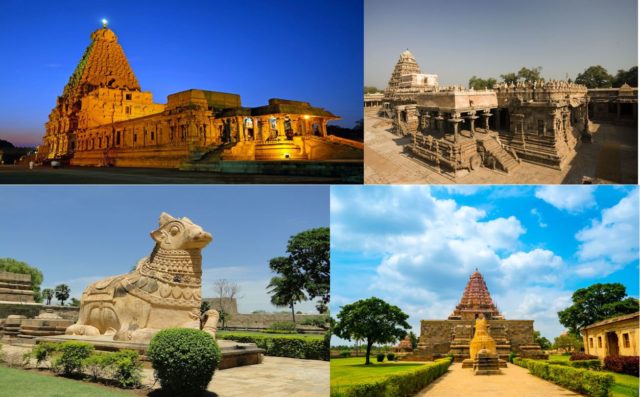
.
19. Group of Monuments at Mahabalipuram,Tamil Nadu, 1984
- The Group of Monuments at Mahabalipuram, in Tamil Nadu, about 58 km from Chennai, were built by the Pallavakings in the 7th and 8th centuries.
- Mahabalipuram's archaeological remains stands as a very good example of the Dravidian architecture. It acted as a port city of the Pallava dynastyin Tamil Nadu in the 7th century.
- Most of these monuments are monolithic, i.e. carved out of one single rock.
- Of the nine monolithic temples found in Mahabalipuram, the most important are Five Rathas known after the famous five Pandava brothers of the Mahabharata fame.
- The Pallavas constructed seven granite temples called as The Seven Pagodas.
- The notable cave temples here are the Varaha mandapa, Mahisamardini mandapa, Paramesvara Mahavaraha Vishnugriha (Adivaraha cave).

.
20. Agra Fort, Uttar Pradesh,1983
- The fortress located on the right bank of the Yamuna River, built in red sandstone.
- The impressive structures built within the precincts of the fort are the Khas Mahal, the Shish Mahal, Musamman Burje (an octagonal tower), Diwan-i-Khas (1637), Diwan-i-Am, white marble mosque or the Pearl Mosque and the Nagina Masjid.
- These monuments are remarkable for the fusion of Persianart of the Timuridand the Indian art form.
- It is very close to the famous Taj Mahalwith a buffer zone separating the two monuments.

.
21. Fatehpur Sikri, Uttar Pradesh,1986
- Fatehpur Sikri, "the City of Victory," was built during the second half of the 16th century by the Mughal EmperorAkbar(1556–1605).
- The complex of monuments and temples, all uniformly in Mughal architectural style, includes one of the largest mosques in India, the Jama Masjid, the Buland Darwaza, the Panch Mahal, and the Tomb of Salim Chishti.
- The English traveller Ralph Fitchconsidered the city in 1585 as 'considerably larger than London and more populous.'
- Its form and layout strongly influenced the evolution of Indian town planning, notably at Shahjahanabad(Old Delhi).
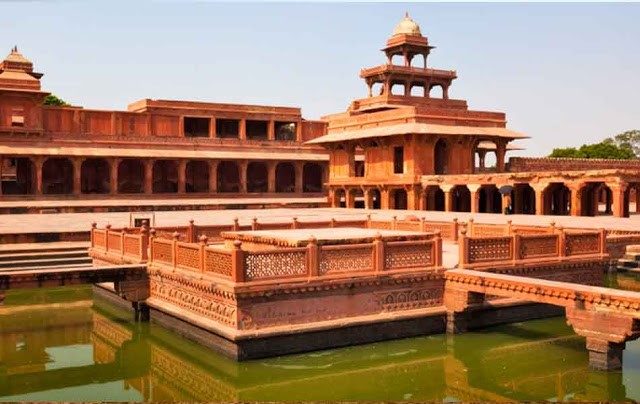
.
22. Taj Mahal, Uttar Pradesh,1983
- Taj Mahal, one of the Seven Wonders of the Worldis a mausoleum– a funerary mosque.
- It was built by Emperor Shahjahanin memory of his third wife Begum Mumtaz Mahalwho had died in 1631.
- It is a large edifice made in white marble in typical Mughal architecture, a style that combines elements from Persian, Islamicand Indian architectural
- This much acclaimed masterpiece was built over a 16-year period between 1631 and 1648 under the Chief Architect Ustad Ahmad Lahauri.
- It is set amidst vast Mughal Gardens, which cover 17 hectares (42 acres) of land on the right bank of the Yamuna River.
- It has an octagonal layout marked by four exclusive minarets at four corners with a pristine elevation of a central bulbous dome below which the tombs are laid in an underground chamber.
- Calligraphic inscriptions in-crusted in polychromaticpierra dura, decorative bands and floralarabesques glorify the monument's graphic beauty and provide a picture perfect impression to the viewers.
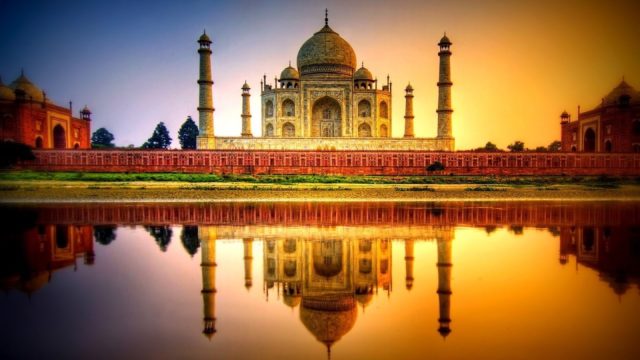
.
23. Mountain Railways of India,West Bengal,1999 2005 2008
- The Mountain Railways of Indiarepresents a collective listing of
- the Darjeeling Himalayan Railway,
- the Nilgiri Mountain Railwayand
- the Kalka-Shimla Railway
- However, the Mountain Railways of India are five railway lines built in the mountains of India in the 19th and early 20th centuries, during the British Raj, which are run even today by the Indian Railways.
- Three out of these five railways, the Darjeeling Himalayan Railway (1881), the Kalka-Shimla Railway (1898) and the Kangra Valley Railway (1924), are located in the rugged hill regions of the Himalayasof Northern Indiaand the other two are much further south in the Western Ghats;
- the Nilgiri Mountain Railwayin Southern India, and the Matheran Hill Railwayin Maharashtra.
- The Darjeeling Himalayan Railway was recognised first in 1999, the Nilgiri Mountain Railway followed suite as an extension to the site in 2005, and in 2008 the Kalka–Shimla Railway was further added as an extension.
 .
.
24. Hill Forts of Rajasthan,Chittorgarh,2013
- Hill Forts of Rajasthan, are a series of sites located on rocky outcrops of the Aravallis mountain range in Rajasthan.
- These hill forts in Rajasthan represent Rajputmilitary strongholds across a vast range of geographical and cultural zones.
- . The property consists of Chittorgarh Fort, KumbhalgarhFort, RanthamboreFort, Gagron Fort, Amber Fort, Jaisalmer Fort. These fort complex includes palaces, Hindu and Jain temples, urban centers and trading centers.
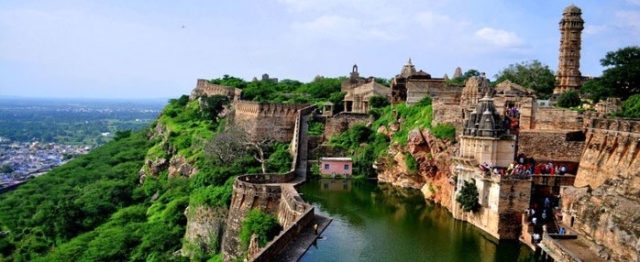 .
.
25. Rani ki vav (The Queen's Stepwell),Gujarat,2014
- Rani ki vav(The Queen's Stepwell) at Patan, Gujarat, is a famous stepwellIt is famous for its size and sculpture.
- The length of Rani ki Vav is more than 64m long, 20m wide & 27m deep and there are more than 500 sculptures of god.
- Most of the sculptures are in devotion to Vishnu, in the forms of Dus-Avatars Kalki, Rama, Mahisasurmardini, Narsinh, Vaman, Varahi and others representing their return to the world. Nagkanya, Yogini beautiful women – Apsara showcasing 16 different styles of make-up to look more attractive called Solah-shringar.
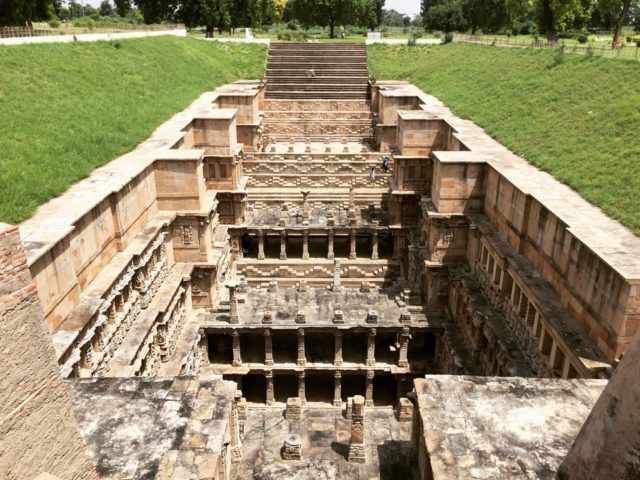
.
26. Nalanda,Bihar,2016
- The Nalanda Mahavihara site is in the State of Bihar, in north-eastern India.
- It comprises the archaeological remains of a monastic and scholastic institution dating from the 3rd century BCE to the 13th century CE.
- Nalanda stands out as the most ancient university of the Indian Subcontinent.
- The historical development of the site testifies to the development of Buddhism into a religion and the flourishing of monastic and educational traditions.
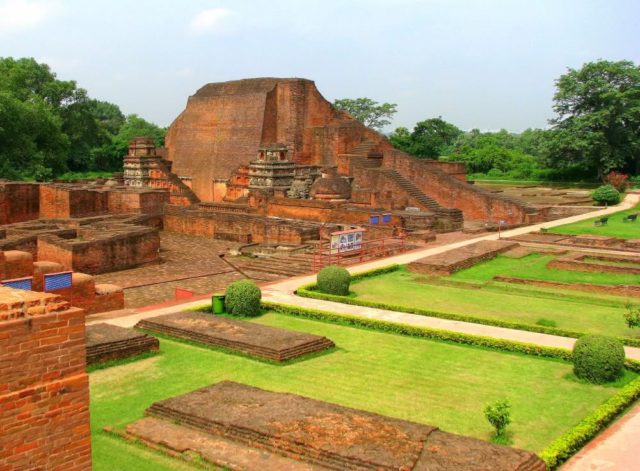
.
27. The Architectural Work Of Le Corbusier,Chandigarh,2016
- Chosen from the work of Le Corbusier, the 17 sites comprising this transnational serial property are spread over seven countries.
- Urban and Architectural Work of Le Corbusier in Chandigarh, is home to numerous architectural projects of Le Corbusier, Pierre Jeanneret, Matthew Nowicki and Albert Mayer.
- He was a French-Swiss architect.
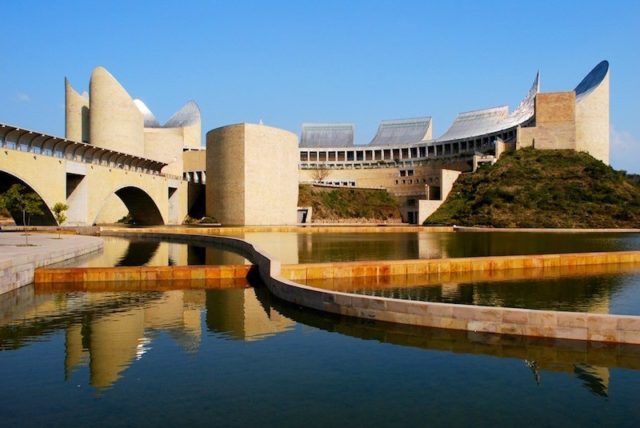
.
28. Historic City of Ahmadabad, Gujarat,2017
- The walled city of Ahmadabad, founded by Sultan Ahmad Shah in the 15th century, on the eastern bank of the Sabarmati river.
- It represents a rich architectural heritage from the sultanate period, notably the Bhadra citadel, the walls and gates of the Fort city and numerous mosques and tombs as well as important Hindu and Jain temples of later periods.
- The urban fabric is made up of densely-packed traditional houses (pols) in gated traditional streets (puras) with characteristic features such as bird feeders, public wells and religious institutions.
- The city continued to flourish as the capital of the State of Gujarat for six centuries, up to the present.
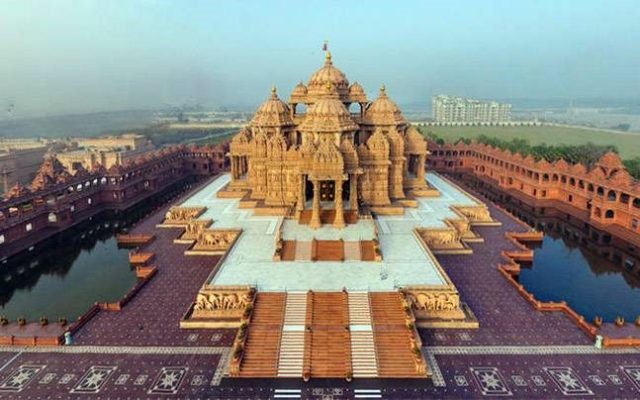 .
.
- - - - - - - - - - - - - - - - - -


